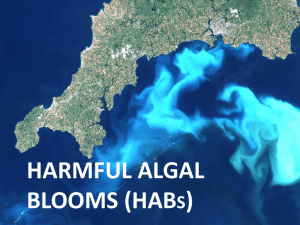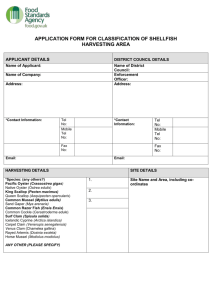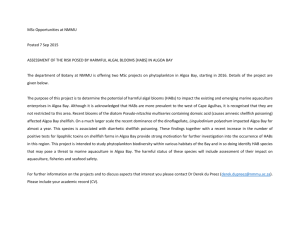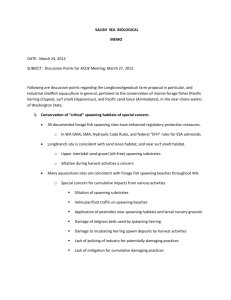Teacher Background
advertisement
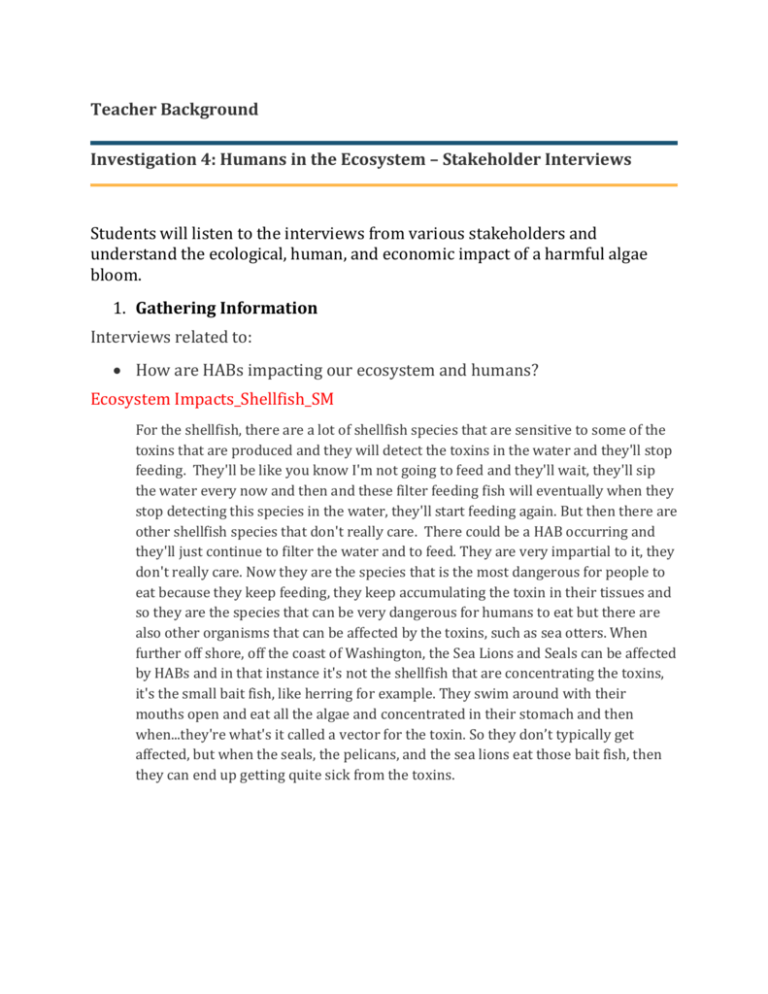
Teacher Background Investigation 4: Humans in the Ecosystem – Stakeholder Interviews Students will listen to the interviews from various stakeholders and understand the ecological, human, and economic impact of a harmful algae bloom. 1. Gathering Information Interviews related to: How are HABs impacting our ecosystem and humans? Ecosystem Impacts_Shellfish_SM For the shellfish, there are a lot of shellfish species that are sensitive to some of the toxins that are produced and they will detect the toxins in the water and they'll stop feeding. They'll be like you know I'm not going to feed and they'll wait, they'll sip the water every now and then and these filter feeding fish will eventually when they stop detecting this species in the water, they'll start feeding again. But then there are other shellfish species that don't really care. There could be a HAB occurring and they'll just continue to filter the water and to feed. They are very impartial to it, they don't really care. Now they are the species that is the most dangerous for people to eat because they keep feeding, they keep accumulating the toxin in their tissues and so they are the species that can be very dangerous for humans to eat but there are also other organisms that can be affected by the toxins, such as sea otters. When further off shore, off the coast of Washington, the Sea Lions and Seals can be affected by HABs and in that instance it's not the shellfish that are concentrating the toxins, it's the small bait fish, like herring for example. They swim around with their mouths open and eat all the algae and concentrated in their stomach and then when...they're what's it called a vector for the toxin. So they don’t typically get affected, but when the seals, the pelicans, and the sea lions eat those bait fish, then they can end up getting quite sick from the toxins. Shellfish and HABs_NT.mov Shellfish are what are called filter-feeders and so what that means is they suck in water, right, and basically they eat whatever is in the water. That's how they get their nutrition, that's how they grow. Okay. So they suck in all this water and then they spit out the stuff that they don't need to eat, right. Most of the time they are eating...they want to eat small algae pieces like the algae, the phytoplankton; I mean those are the things that make them grow. That is their food source but there's a lot of other stuff floating around in the water, right. You've got chemicals; you've got fecal, which is our poop and stuff like that. That's all floating in the water. You've got this algae which some are good algae, some are bad algae, some are having a bad day. Right, they might just have paralytic shellfish poisoning, that toxin that day. All of it comes in. Only a small portion of the bad stuff comes out. Everything else stays in the fish, in the shellfish and it becomes a part of the mussel mass that they have. They eat it, that's what their food source is. That stuff doesn't go away, it stays there. So then the next day shellfish does the same thing, it eats its food, brings in the water, filters out what it wants, let some of it go, and it adds to it. So it's called...they are called filter-feeders by the way they eat and they are also called bio accumulators, which means that what they eat that day didn't go away and then the next day that they eat, it adds to it. So you wind up that the first day it has eaten this algae that may be good, may not have any PSP paralytic shellfish poisoning on it, which is fine. Then the next day it eats some with PSP on it, then the next day it eats more with PSP, so by the end of this you know have this shellfish, this little tiny oyster, or clam, this little tiny nugget of meat inside of it that has a bunch of poisoning, neurotoxins inside of it. Just a little bit and you can't get rid of it. It's part of the mussel of the thing of the shellfish and then what do we do? We crack it open and we eat the mussel, which is where all those toxins have gathered and are hanging out. Then we eat them and typically the amount of the poison that is in there has now accumulated so much that it is now a problem for us. So That when we eat it, we get sick or when a seal or a river otter, any other animal eats it, those toxic affects go over to the animal that eats it and we are a part of what eats the shellfish. What strategies are used to protect public health? HABs and Food scares_JR.m4a Sometimes when people see…you know there might be an effort that might happen to get information out to people. Sometimes that will scare people. If everybody is talking about HABs you know and that they might be in shellfish. Sometimes people will say, ‘Well that sounds too dangerous. I’m just not going to eat shellfish.’ But on the contrary it is kind of a good sign if there is a lot of awareness out there and for people to know that there are these programs in place in the interest of public health and so it swings back to arming with the knowledge and that there is a good program in place. How WA State communicates to businesses of a HAB_JR.m4a How does the state communicate to industry that there may potentially be a water quality issue because of HABs? It depends of the situation For the most part, well umm right now the State has set up a listserv, a mass email communication system and so in the event of any sudden change, the State will send out a mass email to all growers in the State of Washington and they will also call specific growers in the affected areas if there's a HAB in Sammamish Bay. They have a list of every grower and contact information. So they will make personal phone calls to each of those shellfish growers. Mussels as sentinals_NT.mov Mussels are part of that strategy that sits out in the ocean that the WA Department of Health (DoH) looks at. Those guys are the sentinels. It...They feed at a more rapid rate and it gets incorporated to their mussel mass faster. They're the sentinels. So out of all the other filter feeding shellfish that we have in our local waters whether that be oysters, clams, razor clams, butter clams, geoduck, any of that. The mussels are kind of the first ones. They're the sentinel chicken or the canary in the coalmine or however you want to make an analogy of the first the first one that gets sick. You will know that first in mussels which is why they test mussels first and then based on that, they can say oh let's stop this pack because what they want to do is prevent you know everybody else is still eating, so hopefully the people who have eaten the shellfish already aren't going to get sick from what's already out there and then it prevents people from eating shellfish that are still bio accumulating out there until the waters...so for me a good follow up question for that is they keep testing until the waters are clear and then they give a certain amount of dead time after their last clear test to let them start clearing it a little bit out of their system Shellfish tags_S.mov We get a shellfish tag. With every batch that comes in, we have a tag that says where it is from, what time it was caught, everything. We write the date we get it in and it says specifically what farm, the addresses, and even what bed it's in and we have to keep that with every batch of shellfish and at least 80 days afterwards as well and so the FDA, the people who put out the warnings, to say 'hey there's an infection, something happened" that goes directly to wholefoods. It doesn't go through a retailer, it goes directly to whole foods actually and whole foods then withdraws everything because we have that record with that batch of shellfish saying 'oh this is exactly where it is, we need to pull that immediately. We need to send out a warning to our customers to let them know, 'hey we pulled a batch, we didn't sell any or we did sell and we can say because we had that batch number, we also know when it was sold. So if there is anyone who bought shellfish from this day to this day, needs to you know return it, needs to alert us immediately. What should the public know about HABs? What the public should know about HABs_SM So the most important thing should be that HABs occur in this region, they occur most years and they are not always going to discolor the water so the word Red Tide is a bit misleading umm and sometimes there will be a shellfish closure in effect and because people don’t see the water colored red, they think, ‘oh well that's you know...that's not the case, I'm going to dig shellfish and eat them anyway’ and you know that's when you can potentially get very sick. So I think that's probably one of the first things that people should know about HABs is that they have the potential to cause people to become very sick even if the water doesn't appear to be colored red. The thing to do is to always check on Department of Health website and look for shellfish closures. The DOH post where the closures are on their website in a very timely manner and you can go to that website and look up where you can dig for your shellfish and what closures are in affect and that's always a very smart thing to do. What the public should know_S.mov I think the public should know as much as they can. Anything that they are consuming. A member of the public is a consumer but they are also an investor. So we may go to buy, they're investing in this farm and they are investing in their own health. So I think the consumer should know that the biggest one is HABs you can't always see them. It's not a big dust cloud or a big red ball you know. A lot of times HABs like I said earlier are invisible, they are microscopic. So it would be great if they were all actually red, they're not and so you can't just rely on the fact that 'oh I especially consumers that go and farm their own shellfish, they can't rely on the fact that there is no red in the water, I’m safe. I'm going to eat all these shellfish and get really sick. So consumers should really know that it is microscopic and it doesn’t really matter the color. It can be brown, it can be red, it cannot be perceivable to the human eye. So that's the biggest one I think consumers should know and also people should know that there are different levels. Just because if you eat different levels of the way it affects the human body. 2. Additional Information All stakeholders are not represented here, but if students mention other stakeholders for example, the Indian tribes, then the following information would be relevant for their research and challenge: Harmful Algae Blooms and their Impacts on Indian Tribes Historically, shellfish were harvested for subsistence and they featured in ceremonies and ceremonial rites. Clams and mussels were among the favored foods at potlatches (a feast where the host distributes food and gifts to demonstrate wealth and generosity). They are also dried and used as goods for trade with other tribes; for example, “Necklaces” were made of dried horse clams and tree bark. Necklaces were also use to chew on when the Native Americans hiked to their villages east of the Cascade Mountains. Today many of the tribes continue to trade, process and sell shellfish commercially at home and abroad, bringing in substantial revenues to tribal communities. Overall, Native Americans depend on shellfish for subsistence and cultural identity. As HABs become more common and widespread, tribes are being affected, specifically from paralytic shellfish poisoning (PSP). Today, tribes such as the Quileute Indian Tribe are working with researchers and managers to better understand HABs. The Quileute Indian Tribe has partnered with researchers from the Olympic Region Harmful Algal Bloom (ORHAB) to monitor the toxin levels of their shellfish. This is achieved using a new technology called “dipstick” testing where the tribes can rapidly detect the toxin domoic acid in seawater or tissue. For more information: http://www.orhab.org/outreach/RedTides2002.pdf

